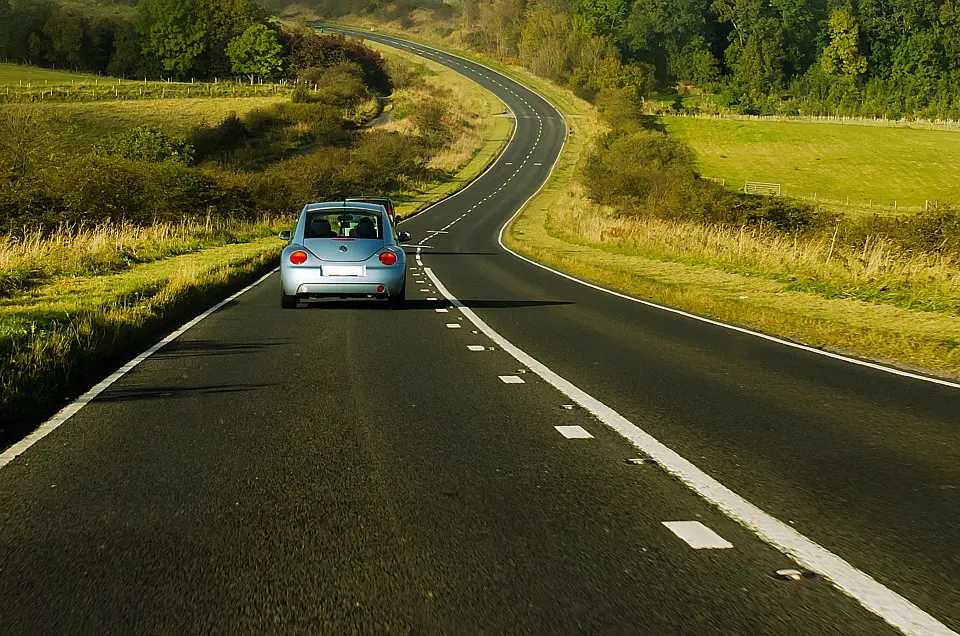Road trips are easily our favorite way to travel, whether it’s jumping in the car or campervan to hit the road. There’s something so alluring about the open road with the freedom and spontaneity that comes with it. It’s the way the road snakes endlessly ahead, surrounded by stunning scenery, and it’s the liberation to stop wherever you please while discovering hidden gems along the way.
Imagine going on a Sunday drive with the family. Where do you go? Do you head into the city, seeking the pleasure of stoplights and billboards . . . or do you head out of town? If you are like me, you head for open country, feeling a sense of release as you leave a busy city full of flashing lights, sirens, and honking horns.

(Pixabay / PublicDomainPictures)
The scenery may be more attractive in the country, but is it a safer place to drive? Are we actually escaping a high-risk driving zone when leaving the urban cityscape, as commonly assumed? How safe is that upcoming road trip really?
Driving in urban and rural areas differs in some significant ways. For example, country and city roads differ fundamentally in the density of traffic, the number of large trucks, and the number of bicyclists and pedestrians sharing the road. Unsurprisingly, pedestrian and bicyclist deaths are more prevalent in urban areas, whereas passenger and large truck deaths occur at higher rates in rural areas.
Despite this fact, the average driver may be surprised to learn that rural roads are more dangerous than urban roads per mile driven. Although only 19 percent of people live in rural areas, and only 30 percent of vehicle miles traveled occur in rural areas, almost half of automobile-related fatalities occur in rural settings, according to the U.S. Department of Transportation.
The high rate of rural fatalities associated with automobile driving may be linked to the following 5 factors:
- Fatigue – According to the AAA Traffic Safety Foundation, an estimated 21% of fatal crashes involve a drowsy driver, and fatigued drivers are generally considered as hazardous as those under the influence of drugs or alcohol. Rural roads lend themselves to fatigued drivers who stay behind the wheel for more hours to reach their far-flung destinations
- Speed – Posted speed limits are higher on rural roads. Rural highways in Nevada have some of the highest speed limits in the country, at 70 to 80 mph. A crash at these speeds is exponentially more likely to end in fatalities than a crash at 50 to 60 mph or one at 40 mph. Although most rural traffic fatalities don’t occur on main highway arteries, but on so-called collector roads and local roads (source), drivers who exit high-speed highways travel faster on these types of roads than those who exit slower, urban highways.
- Law Enforcement – Drivers on rural roads may be more likely to disregard speed limits because of decreased law enforcement presence. Drivers perceive that speeding on a backcountry road is less likely to result in a traffic violation or speeding ticket. In addition, rural drivers justify speeding by the low traffic and population density, assuming that their fast driving poses little risk to others.
- Alcohol and the Lack of Public Transportation – Driving under the influence of drugs and alcohol is a bigger problem in rural areas because of the lack of public transportation. Rural partiers can’t hail a cab or catch a subway when they are intoxicated. The large distances between private dwellings make it less likely that one designated driver could feasibly drive everyone safely home after a night out.
- Dangerous Roads – Deer jumping in front of cars in the American West is a serious risk on rural roads, especially at night. Rock falls, loose livestock, road disrepair, and poor weather at high speeds are hazards for rural drivers on roads with higher speed limits. Rural roads can be winding and involve rapid elevation gains and losses. The combination of curves in the road, high travel speeds, and driver fatigue can be fatal. Rural roads often lack shoulders on the side of the road.
America’s roads are some of the safest roads in the world. This article is not meant to scare anyone away from a memorable road trip. Rather, this article’s purpose is to challenge the common notion that city driving is somehow more threatening or dangerous than country driving and to remind all of us to practice as much vigilance on country roads as we do when we are downtown.
Don’t drive while intoxicated or fatigued, don’t speed, and don’t be casual about risking the lives of the people around you. Never drive faster than your guardian angel can fly. And, if the unthinkable happens, and driving results in injury or even death, find out if an auto accident lawyer can help you claim losses that have been caused by another’s negligence.
If you or a loved one has suffered injuries, you have the right to file a personal injury claim with a licensed accident injury attorney near you. If you have tragically lost a loved one in an automobile accident, you have the right to file a wrongful death suit and seek compensation from those who are found responsible. Attorneys such as those at Tingey Injury Law Firm have specific expertise in this aspect of law and give free consultations to discuss your case. No fee will be collected unless your case is successful, so there is no reason for you to postpone finding out more.
Video

